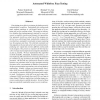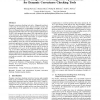64 search results - page 12 / 13 » Certifying Program Execution with Secure Processors |
OOPSLA
2007
Springer
13 years 11 months ago
2007
Springer
Omniscient debuggers make it possible to navigate backwards in time within a program execution trace, drastically improving the task of debugging complex applications. Still, they...
ICCD
2006
IEEE
14 years 2 months ago
2006
IEEE
—Current micro-architecture blindly uses the address in the program counter to fetch and execute instructions without validating its legitimacy. Whenever this blind-folded instru...
NDSS
2008
IEEE
13 years 11 months ago
2008
IEEE
Fuzz testing is an effective technique for finding security vulnerabilities in software. Traditionally, fuzz testing tools apply random mutations to well-formed inputs of a progr...
TDSC
2010
13 years 3 days ago
2010
We describe Instruction-Set Randomization (ISR), a general approach for safeguarding systems against any type of code-injection attack. We apply Kerckhoffs' principle to creat...
PLDI
2010
ACM
13 years 10 months ago
2010
ACM
Dynamic correctness checking tools (a.k.a. lifeguards) can detect a wide array of correctness issues, such as memory, security, and concurrency misbehavior, in unmodified executa...


